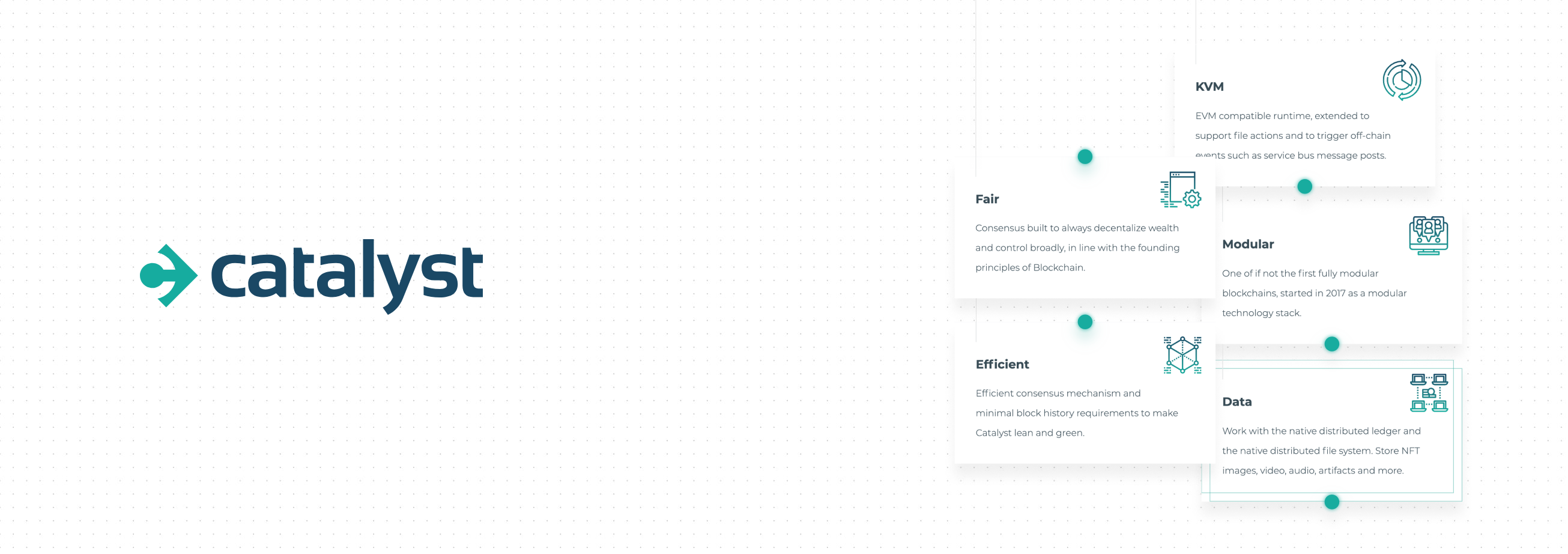Introducing Catalyst Network
Catalyst Network aims to be a complete, developer-friendly platform for building feature-rich Web3 applications. Leveraging a new consensus mechanism, an integrated distributed file system, and the KVM (Kat Virtual Machine), Catalyst is designed to deliver scalability, security, and simplicity for decentralized projects.

Probabilistic BFT Consensus
Construct, campaign, vote, and synchronize — a four-phase process with Bloom-filter optimization and randomized producer selection via RANDAO.
Distributed File System
IPFS-inspired architecture for large-scale content storage, with pinned files and unique content identifiers.
Sparse Merkle Trees
Compact data structure for storing/verifying ledger state, enabling straightforward proofs and fast sync.
Kat Virtual Machine
Extended EVM (KVM) with new opcodes and precompiled contracts for DFS reads/writes, cryptography, and advanced on-chain logic.
C# + dotNetty Implementation
A robust, modern .NET stack for high-performance P2P networking and modular, maintainable code.
The Challenge
Modern decentralized applications require more than simple token transfers. They demand robust on-chain logic, privacy, efficient storage, and high throughput. While popular blockchains made significant breakthroughs in permissionless finance, they often fall short in scalability, developer experience, or efficient data handling. Catalyst Network set out to solve these core issues by uniting powerful consensus, flexible file storage, and extended smart contract functionality into one seamless stack.
Overview & Vision
Catalyst Network is presented as a full-stack solution for the decentralized web, integrating multiple components:
• Probabilistic Byzantine Fault Tolerance (PBFT) Consensus – A novel approach that moves away from purely competitive methods (like Proof-of-Work) toward collaborative validation with minimal wasted energy.
• Distributed File System (DFS) – Inspired by IPFS to ensure data persistence without forcing every node to store the entire blockchain history.
• KVM (Kat Virtual Machine) – An enhancement of the EVM (Ethereum Virtual Machine) which supports new precompiled contracts, cryptographic primitives, and integrated DFS operations.
All components aim to improve transaction throughput, developer experience, and on-chain logic.
Consensus Mechanism
Catalyst's consensus relies on a PBFT-like process, designed to be more energy-efficient than Proof-of-Work. Producers (validators) are chosen randomly via a RANDAO-inspired selection process, which mitigates manipulation attempts. Once chosen, producers collaborate through four stages—Construction, Campaigning, Voting, and Synchronization—to finalize ledger updates. The system employs Bloom filters to reduce overhead when sharing producer lists, and DotNetty in C# powers the underlying peer-to-peer networking layer.
Distributed File System (DFS)
By integrating a DFS module (similar to IPFS), Catalyst decouples large file storage from the core blockchain data, enabling:
• Lightweight Nodes: Only store the ledger state and any files they choose to pin.
• Content Addressing: Each file is identified by a unique hash (CID), preventing duplication and ensuring data integrity.
• Persistent Storage: Nodes can opt into storing data for other participants, earning rewards for pinned content.
This approach drastically reduces on-chain bloat while providing a robust platform for storing large assets or complex data structures.
Global Ledger State & Sparse Merkle Trees
The Catalyst ledger state uses a Sparse Merkle Tree to represent all account balances, contract storage, and other key data. Sparse Merkle Trees:
• Offer concise proofs of both inclusion (the data is there) and non-inclusion (the data is absent).
• Are easy to synchronize for new nodes, which only need the minimal state deltas.
• Ensure immutability and versioning, since old states are never overwritten, just extended.
By referencing these tree states in each consensus cycle, nodes can rapidly verify ledger updates without storing the entire transaction history.
KVM (Kat Virtual Machine)
An evolution of the Ethereum Virtual Machine, KVM adds new precompiles and enhanced functionality to support advanced cryptographic operations and DFS interactions. Notable features:
• Backwards-Compatible with EVM: Existing Solidity contracts can migrate easily.
• Extended Opcodes: Built-in functionality for reading/writing to the Catalyst DFS and generating complex proofs (e.g., range proofs).
• Improved Development Experience: Developers can focus on business logic rather than manually implementing advanced cryptographic primitives or storage handling.
Implementation in C# & DotNetty
Catalyst is implemented in C#, leveraging DotNetty (a .NET port of Netty) to handle peer-to-peer communication:
• High Performance: DotNetty's asynchronous architecture helps manage a large number of concurrent nodes efficiently.
• Modular Design: Components for consensus, DFS, KVM, and ledger state can be independently tested, updated, and maintained.
• Extensive Tooling: The .NET ecosystem provides robust libraries for cryptography, storage, and networking.
This choice of technology ensures Catalyst remains flexible, maintainable, and performant at scale.
Don't Wait, Build the Future of Web3 with Catalyst!
Leverage advanced consensus, integrated file storage, and a powerful extended EVM to supercharge your decentralized applications. Whether you're building DeFi protocols, enterprise services, or next-gen dApps, Catalyst Network provides the foundation you need.